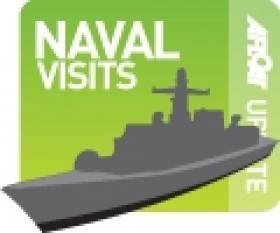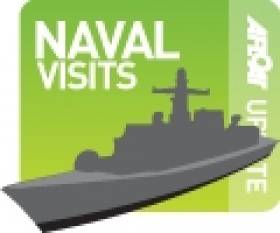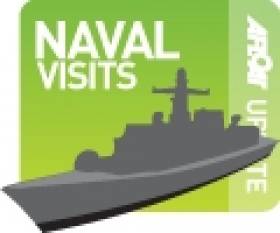Displaying items by tag: Royal Netherlands Navy
‘Stealth’ Designed Dutch Class Frigate Calls to Dublin Port
#DutchStealthFrigate - An air-defence and command frigate (LCF) of the Royal Netherlands Navy HNLMS De Zeven Provinciën (F802) docked in Dublin Port today for a three-day visit, writes Jehan Ashmore.
The Dutch Embassy in Ireland through Ambassador Schellekens has cordially invited the general public to an open viewing/tour on Saturday 12th September.
This offer should be recognised and welcomed given the berth location of the frigate is in the heart of the port rather than the more usual berthing of foreign naval ships at the more accessible city-centre location along Sir John Rogersons Quay.
The tour begins at 11am (noting, to book a place is on a first served basis and requiring private transport to reach Ocean Pier accessed via Alexandra Basin).
It is strongly advisable to bring a Photo ID and to carefully read for further instructions, (before emailing of this boarding opportunity) by clicking the Embassy link HERE.
The ‘Provinciën’ class fast-frigate (30 knots) which carries missiles is the leadship of a quartet commissioned in 2002.
She along with her sisters of 6,050 tonnes, have a striking stealth design technology in that the superstructure has sharp angular angles to reduce radar signature.
All of the frigates were built by Royal Schelde which completed the final newbuild in 2005 thus completing a programme to replace the ‘Tromp’ class and ‘Jacob van Heesmarck’ Class frigates.
The armament of the ‘Provinciën’ class, are as listed: Oto Breda 127mm cannon, Vertical Launch System (VLS) Mk 41 for Enhanced Sea Sparrow Missile (ESSM) and Standard Missile (SM), Harpoon Missile (HM), Goalkeeper (rapid-fire gun), Mk. 46 Torpedo weapon system, NH-90 helicopter.
In 2013 off the US north-east coast she carried out exercises in the firing of an ESSM, a SM and two HM’s (see video above).
On her arrival to Dublin Bay, the frigate took on a pilot from cutter Camac off Howth from where she continued on into the port approach channel.
While this was taking place, the Dublin Port tug sisters Beaufort and Shackleton were awaiting within the port fairway to carry out in assisting the berthing of the 144m long frigate alongside Ocean Pier. The berth, No. 35 is located on the fairway between the West and East of the Alexandra Basins.
Upriver beyond the East-Link toll lift bridge is where another foreign navy visitor, the German Navy sail-trainee barque Gorch Fock has graced the south quays.
The three-masted ship will also be open to the public next weekend, albeit only on the following Sunday, 13th September. For further details of “Open Ship” tours click to our previous coverage here.
Also calling to the capital during the summer was the Royal Navy frigate HMS Monmouth (F235), she along with her ‘Duke’ class frigates are quite regular visitors to the port.
#LandingDockShip- HNLMS Johan de Witt (L801) an imposing yet impressive amphibious transport ship and HNLMS Amsterdam (A386) an auxiliary oil replenishment tanker of the Royal Netherlands Navy are to call to Dublin Port tomorrow, writes Jehan Ashmore.
HNLMS Johan de Witt is one of two such vessels also known as Landing Platform Docks (LPD) in the Dutch Navy and she is an enhanced verion of leadship class nameship HNLMS Rotterdam (L800) which has visited the capital before. The LPD half-sisters play an integral role in supporting ships in amphibious operations.
Earlier this month both the Dublin bound vessels formed part of a flotilla involved in exercises in the Irish Sea as they proceeded northbound.
HNLMS Johan de Witt is ten metres longer at 166m of 'Rotterdam' and can handle between 6-8 landing craft and is 16,500 tonnes. She will berth at Ocean Pier berth due to her 6m draft and likewise the 17,040dwt auxiliary oil replenishent (AOR) at sea vessel, HNLMS Amsterdam which has a larger draft of 8m. She is equipped with weapons systems and has a helideck and hanger for such aircraft.
The weapons systems of HNLMS Johan de Witt are .50 mm machine guns, 2 x Goalkeeper 30 mm and helicopters of 6 Lynx, NH-90, Chinook or Sea King helicopters. She can embark 600 units compared to her sister with that of 555 units.
The LPD can cater for either Landing Craft Vehicle and Personnel (LCVP) or Landing Craft Utility (LCU). In addition she can transport almost any type of vehicle. As well to carrying 32 Leopard 2 tanks and approximately 90 YPR armoured tracked vehicles and Patriot air-defence systems.
She is designed to be self-sufficient for at least a month and this involves supplies on board for a complete marine battalion and the ship's company. They are equipped with operating tables, intensive-care beds, treatment rooms and an emergency hospital for 100 patients.
Final Naval Visitor to Dock in Dublin Port
#NavalFlotilla – With the Royal Navy's HMS Illustrious (RO6) already docked in Dublin Port along with German and French naval vessels, the port is expecting a final member of the visiting European naval flotilla this afternoon, writes Jehan Ashmore.
Berthed near to HMS Illustrious are the German Navy's oil replenishment tanker FGS Rheon (A1443) and Sachsen class frigate FGS Hessen (F221). Also in port is the French Navy's Marne (A630) another replenishment oil tanker.
While offshore of Dublin Bay is the remaining vessel due to arrive, the Royal Netherlands Navy HNMLS Luymes (A803) a hydrographic research vessel. The 2,091 tonnes vessel has completed carrying out exercises off Scotland along with her European fleetmates.
Only HNMLS Luymes is to berth closer to the city-centre along Sir John Rogersons Quay, which requires a transit through the East-Link lift toll bridge this afternoon.
The Naval Service L.E. Emer (P21) is also to moor alongside the south quays though not till tomorrow morning.
Dutch Naval Flotilla Head for Dublin Port Visit
#DUTCH NAVAL VISIT – A torpedo training ship HNLMS Mercuur (A 900) is one of four vessels of the Royal Netherlands Navy based in Den Helder which are scheduled to visit Dublin Port next weekend, writes Jehan Ashmore.
During the four-day call, the HNLMS Mercuur and the Alkmaar class minehunter HNLMS Vlaardingen (M 863) will be open to the public on the Saturday and Sunday between 2pm-4pm. All the vessels will be berthed alongside Sir John Rogersons Quay.
HNLMS Mercuur is fitted with a maintenance shed for torpedoes and as a target ship for submarines to fire dummy torpedoes. She has an armament of 1 underwater launch tube for Mk. 48 torpedoes. The 64.8m vessel has a crew of 39 and the vessel which displaces 1,400 tonnes is powered by a 2 x MAN 6L-20/27 diesels (1,632 hp total) which deliver 14 knots.
The 41.5m long navy training ship (MOV) Van Kinsbergen (A902) is used for practical nautical training, a task for which it was specifically built and equipped. In addition to the navigation bridge, the MOV Van Kinsbergen has a second, fully equipped training bridge. There are five-crew and also the same number of civilian crew.
A second Alkmaar class vessel HNLMS Zierikzee (M862) forms the final member of the flotilla. Each of the 51.5m long vessels which weigh 534 tonnes has a crew ranging between 28-38 personnel. The Alkmaar class origin is a joint design of the Netherlands, Belgium and France navies.
The Dutch constructed the propulsion system, the Belgiums provided the electronics and the French built the mine-hunting equipment. To reflect the cooperation between the three countries, the international name of this class of ship, are referred as the Tripartite class.
































































